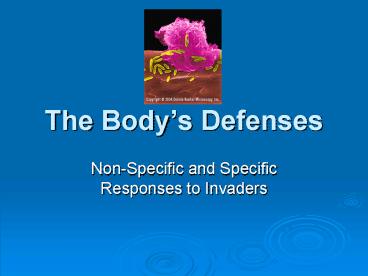The Bodys Defenses - PowerPoint PPT Presentation
1 / 14
Title:
The Bodys Defenses
Description:
Diagram: www-ermm.cbcu.cam.ac.uk/ fig002akh.gif 587 x 510 pixels - 49k. Lesson #4: ... .com/. ../macrophage.jpg489 x 500 pixels - 65k. Fighting Back ... – PowerPoint PPT presentation
Number of Views:112
Avg rating:3.0/5.0
Title: The Bodys Defenses
1
The Bodys Defenses
- Non-Specific and Specific Responses to Invaders
2
Immune System Primer
- The Immune System Primer offers a self-directed
study of the Human Immune System. It is
designed to give general biology students basic
knowledge of the various mechanisms the body
employs to defend itself against foreign
invaders. It contains links to a number of
on-line animations and reference materials. - Diagram http//www.niaid.nih.gov/final/immun/immu
n.htm
3
Invitation to Learn
- Employees
- must wash hands before returning to work
- Hepatitis A Scare
4
Objectives
- Identify the role each item plays in fighting an
infection skin, mucus, saliva, sweat,
phagocytes, natural killer cells, fever, B cells
and T cells - Identify four symptoms of inflammation
- Describe the importance of washing ones hands
- Explain how Hepatitis A virus is spread
- Compare and contrast T and B cells
5
Objectives
- Define the following terms adaptive immunity,
antigen, antibody, histamine, immunology, innate
immunity, lymphocyte, pathogen - Use leucocytes to describe the process of cell
differentiation - Describe the immune response
- Identify four major types of infectious agents
6
Objectives
- Distinguish between a primary immune response and
a secondary immune response - Using leucocytes, provide examples of how cell
structure is related to function - Compare and contrast plasma and memory cells
7
MA Frameworks
- 2.1 Relate cell parts/organelles to their
function - 2.5 Explain the role of cell membrane as a highly
effective barrier - 4.1 Explain how major organ systems in humans
have functional units with specific anatomy that
perform the function of that organ system
8
Lesson Plans
- Lesson1
- Invitation to Learn
- Lesson 2
- Non-Specific Immunity
- Lesson 3
- Specific Immunity
- Lesson 4
- Primary and Secondary Immune Response
- Photo http//www.denniskunkel.com/PublicHtml
9
Lesson 2 Non-Specific Immunity
- Compare and Contrast Phagocyte
- and Natural Killer Cell
10
Lesson 2 Non-Specific Immunity
- Identify four symptoms of inflammation
- Identify the role each item plays in fighting an
infection skin, mucus, saliva, sweat,
phagocytes, natural killer cells, fever, B cells
and T cells - Inflammatory Response
- Photohttp//www.msu.edu/course/lbs/145/smith/s02/
graphics/freeman_46.2b.jpg
11
Lesson 3 Specific Immunity
- Use leucocytes to describe the process of cell
differentiation - Compare and contrast T and B cells
12
Lesson 3 Specific Immunity
- Describe the Immune Response.
- Diagram www-ermm.cbcu.cam.ac.uk/ fig002akh.gif
587 x 510 pixels - 49k
13
Lesson 4 Primary and Secondary Immune Response
- Graph http//academic.brooklyn.cuny.edu/biology/b
io4fv/page/aviruses/helperTcells.html - Distinguish between a primary and secondary
immune response
14
Summary
- Photo www.creationscience.com/.
../macrophage.jpg489 x 500 pixels - 65k - Fighting Back































